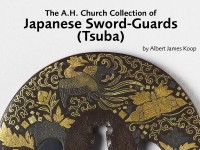The A. H. Church Collection of Japanese Sword-Guards (Tsuba)
An unpublished catalogue of the A. H. Church collection of Japanese sword-guards (tsuba) by Albert James Koop.

Gotō [Japanese text] Shirobei Masaoku (d. 1512), a samurai of Mino province, better known by his art-name Yūjō, founded a school which, like those of the Nara and the Yokoya , was destined to exert a most potent and lasting influence on the subsequent groups in this series.
Yūjō, working at the Kiōto for the eighth Ashikaga Shōgun, Yoshimasa, established the classical Gotō style (known as iye-bori, “the carving of the house”), and this was closely followed by the five succeeding Masters (in direct descent), as well as by a number of famous pupils and the branches founded by them.
Sword-mounts in this classical Gotō style remained till the very latest date the correct wear for shogunal court ceremonies, but until the time of the 5th Master of the main school, Tokujō (1549-1631), guards were not included among the productions of Gotō workers. Characteristic features are the use of shakudō as a groundwork, plain save for the nanako or “fish-roe” granulation (an invention credited to Yūjō himself) and the disposition on it of animal or other reliefs treated in a somewhat severe manner, in incrustation of gold or gilt metal.
The 7th Master, Kenjō (1585-1663), broke away from the rigid traditions of the classical style, and, like most of the succeeding nine Masters and their pupils, tended to greater variety and naturalism in manner and design.
Under Renjō, the 10th Master (1627-1709), the main school migrated to Yedo, where the rivalry of the now fashionable Nara and Yokoya styles tempted it still further from the classical iyebori. Much the same story must be told of the various branch schools, and the new styles thus originated are illustrated in the next group.
 Tsuba with dragon and clouds (EAX.10883)
Tsuba with dragon and clouds (EAX.10883)
 Tsuba with wisteria (EAX.10884)
Tsuba with wisteria (EAX.10884)
 Tsuba with lespedeza foliage and flowers (EAX.10885)
Tsuba with lespedeza foliage and flowers (EAX.10885)
 Tsuba with grape vine (EAX.10886)
Tsuba with grape vine (EAX.10886)
 Tsuba with heraldic chrysanthemums and leaves (EAX.10887)
Tsuba with heraldic chrysanthemums and leaves (EAX.10887)
 Mokkō-shaped tsuba with peonies (EAX.10888)
Mokkō-shaped tsuba with peonies (EAX.10888)
Notice
Object information may not accurately reflect the actual contents of the original publication, since our online objects contain current information held in our collections database. Click on 'buy this publication' to purchase printed versions of our online publications, where available, or contact the Jameel Study Centre to arrange access to books on our collections that are now out of print.
© 2013 University of Oxford - Ashmolean Museum








